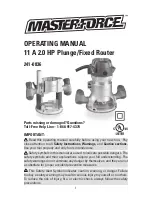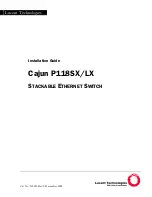
12
13
OPERATING THE ROUTER
• Place the router on the workpiece and turn it on.
• Slowly push the router downward until the milling cutter contacts the
workpiece.
• Mill out the groove using a continuous, even motion.
• When the milling process is complete, raise the router and turn it off.
ELECTRONIC SPEED ADJUSTER
The speed of your router is variable (6 variable speeds). Use the variable
speed dial (9) to produce uniform results in wood, plastics and similar
material. Use lower settings for large diameter bits and higher settings for
small diameter bits.
USING THE ROUTER
• Make sure that the material to be cut is securely clamped and provides
sufficient stability to support the router while it is operating.
• To control the router, keep both hands on the grips.
• Rotate the router counter-clockwise when cutting outside edges. Rotate it
clockwise when cutting inside edges.
• Always hold the router from the front, ensuring that the chip shield is
between yourself and the bit.
• After setting the cutting depth as described, position the router so that
the bit is directly above the point you plan to cut. With the router running,
lower the unit smoothly into the workpiece. (DO NOT FORCE THE ROUTER
DOWN.) When the tool reaches its pre-set depth, tighten the plunge
release lever. Once you have finished routing, loosen the plunge release
lever and allow the spring to lift the router directly out of the workpiece.
NOTE:
Always feed the workpiece to the router against the direction of the
bit’s rotation.
FEED SPEED AND RATE OF CUT
Feed rate depends on the material and bit configuration. Experience is the
best guide. Become familiar with the sound and feel of the router by making
practice cuts on scrap materials. Perform a preliminary adjustment of the
speed control, selecting a higher speed for smaller diameter bits and a lower
speed for larger diameter bits.
The router bit rotates at a very high speed and may heat up, causing burn
marks if the router is moved too slowly through the wood. Feeding the
router too quickly or trying to remove too much material in a single pass will
overload the motor. Use two or more passes for extra-large cuts, especially
in the case of hardwood.
ROUTING WITH AN EDGE GUIDE
The edge guide is an accessory that allows you to rout a straight groove or
other shape parallel to the edge of your workpiece.
Mount the edge guide as following:
• Loosen the two lock bolts on the router
• Feed the metal rods on the edge guide through the holes in the router’s
base.
• Adjust the distance between the router bit and the edge guide by moving
the guide until it is at the correct distance.
• Tighten the lock bolts to secure the edge guide in position.
• Place the router on the edge of the workpiece with the bit not contacting
the workpiece.
• Turn the router on and allow the motor to reach full speed.
• Gradually move the bit toward the workpiece
• When cutting is complete, turn the router off and let the bit come to a
complete stop before removing the router from the workpiece.
CHIP SHIELD DEFLECTOR (Fig.9)
WARNING:
ALWAYS wear eye protection. The chip shield deflector
is intended as a safety guard.
The chip shield deflector help keep dust and chips away from the operator;
they will not stop objects larger than woodchips thrown from the bit. The chip
shield deflector on the plunge base is held in position by a screw. To remove
the shield from the plunge base, simply remove the screw and take the shield
off of the base.
WARNING:
The chip shield
deflector helps keep dust and chips
away from the operator; it will not
stop objects larger than woodchips
thrown from the bit.
CAUTION:
ALWAYS have the
chip shield deflector in place on the
base when operating the router.
DUST COLLECTION WITH DUST
Fig. 9
screw
Summary of Contents for 241-0836
Page 9: ...16 17 Exploded View ...
Page 10: ...18 19 ...






























